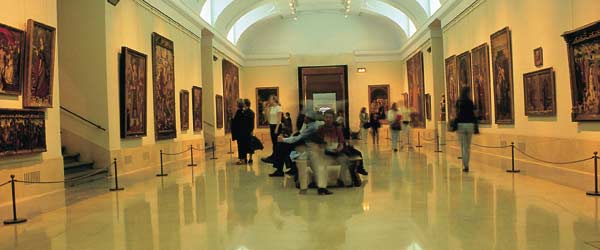Cultural day out in Madrid
You can do a lot of things in one day in Madrid. You can visit the largest art gallery in Spain and stroll around the gardens and halls in the Royal Palace, and enjoy a range of gastronomic delights.
At a leisurely pace but with a carefully planned schedule to make the most of our day of culture.
Let’s get going:
Morning
Prado Museum: a compulsory stop on your itinerary (approximately two and a half hours. Suggested timetable: 9:30 am-12 pm)
A good time to start the visit would be at 9:30 am. That way we avoid the crowds and can make the most of our time in the museum. Our aim is to see all the most important works in a single morning.
If we are planning to spend a whole day in Madrid, one option would be to visit the permanent collection for two hours and save a little time for the rooms that most interest us, or for the temporary exhibitions. On our route around the museum we should be sure not to miss the towering works of European masters such as Hieronymus Bosch, Goya, Roger van der Weyden, Fra Angélico, Velazquez, Tintoretto and Rubens.
Things to remember
The use of audioguides is highly recommended, as not all the paintings have descriptions in English.
You can hire a private guide for your visit. You'll find them at the entrances to the museum, wearing an identifying label from the Madrid Region on their jackets.
Group access is through the Murillo door.
It is a good idea to pick up a map at the information point.
Entry is free the last two hours of opening every day and the last three hours on Sundays.
The museum is closed on Mondays.
Fortify yourself as the Spanish do: stop for a “pincho”
We finish the visit at around 12 pm, which is the perfect time to have a bite to eat or a “pincho” (light mid-morning snack). There is a café inside the Prado itself, but there are other options available in the surrounding area.
For example, in the Plaza Cánovas del Castillo square there are cafés with pavement terraces with views of Neptune’s fountain. And, if we continue for a few metres on the other side of the road from the Prado, we reach the Thyssen – Bornemisza Museum which has a well-known restaurant with an open-air terrace, ideal on a sunny day. Good recommendations to whet your appetite are the Spanish potato omelette, patatas bravas (potatoes with a spicy sauce), or potatoes with alioli (garlic mayonnaise), Iberian cured ham, croquettes, squid or marinated anchovies. The usual custom in Madrid is to enjoy them with a small glass of beer or wine.
Midday
A walk up to the Puerta del Sol squar
The best way to get to know a city is by strolling through its streets, and as this point is so near the Puerta del Sol, it's a good time to take a walk of about an hour around the area known as the Madrid of the Bourbon dynasty.
Right in front of Neptune’s fountain there is a tourist information point where you can pick up a map of the old part of Madrid.
We set off along the Paseo del Prado, moving away from the Prado but on the same side of the street. On the way we pass some distinctive buildings. First, we see the Madrid Stock Exchange on our right. Then the Plaza de la Lealtad square and the Naval Museum, next to the Navy Headquarters. We then come to the Cibeles fountain, a perfect place to take out the camera. The most popular photos show the fountain with the Cibeles palace in the background; the Linares palace and the Banco de España (the Spanish central bank). A little further on there is another excellent photo opportunity, as you’ll see the Puerta de Alcalá gate on your right and the famous Gran Vía avenue on your left
We continue on along up Calle Alcalá on the same side of the street as the Banco de España, and we see the Cervantes Institute in front of us. We go on and turn into the Calle Marqués de Cubas, which brings us out in the Plaza de las Cortes (Parliament square), opposite the Congress building. A few minutes’ walk along the Carrera de San Jerónimo brings us to the Puerta del Sol, another sight not to be missed. By the way, don’t be surprised if you see a group of people staring at the pavement under the clock in the Puerta del Sol; they’re looking for Km 0, which marks the point at the very centre of the country.
Typical Madrid fare
It is now about 1:30 pm, the perfect time for lunch, and we are in the best possible place for it. There are numerous restaurants serving typical local fare around the Puerta del Sol. Most of them are to be found in streets such as Tetuán, Carmen, Carretas, Victoria, de la Cruz and Mayor, among others. If you really want to enjoy the local gastronomy, you can have a canapé beforehand accompanied by a glass of vermouth on tap. Then, for lunch, try dishes like the cocido madrileño (chickpea stew), tripe, or baked sea bream. To drink, we recommend sangría, a glass of beer or a good wine.
We suggest moving somewhere else for dessert, and then having coffee in the Plaza Mayor square, which is reached by walking up the Calle Mayor. If it’s sunny, this is a perfect opportunity to get to know this square at length.
Afternoon
An afternoon in the company of kings and queens
After lunch we can visit Madrid’s Royal Palace and its magnificent surroundings. At about 4 pm we reach our first stop, about ten minutes’ walk along the Calle Mayor and through the Plaza de la Villa square, the site of the Town Hall.
Things to remember in the Royal Palace
It's a good idea to arrive at least 45 minutes before closing. Once inside, you can continue your visit until up to 45 minutes after the doors close.
The visit lasts about an hour and a half.
Guided visits are only to the royal quarters, and are in groups (maximum 30 people)
The ceremonial changing of the Royal Guard takes place every first Wednesday in the month at midday inside the Palace grounds.
On all other Wednesdays the changing of the Royal Guard is held at the Prince’s Gate between 11 am and 2 pm.
The autoguides include explanations of the royal quarters, the Royal Armoury and the Pharmacy.
The descriptions of the items on display are given in English and Spanish.
Plaza de Oriente square and the gardens of the Royal Palace
We will end our visit to the Royal Palace at about 6 pm. This is a good time to stroll around and relax in these beautiful surroundings, including the Sabatini and Campo del Moro Gardens, the Plaza de Oriente square, the Teatro Real opera house and the Almudena Cathedral. We can stop off for a rest in one of the bars in the Plaza de Oriente square, from where we have a good view of the Palace.
Things to remember
Sundown is a perfect time to visit this area and for strolling along Calle Bailén and through the Plaza de Oriente square.
The most beautiful views of the Royal Palace are to be had from the Campo del Moro and Sabatini gardens.
The best views of the Almudena Cathedral are from the Vistillas gardens (a few metres past the Cathedral along the Calle Bailén, moving away from the Palace) or from Calle Rebeque or Calle del Factor.
Evening
By this time we will be wanting something a little more leisurely, maybe some browsing in the shops and a quiet dinner in the centre. A good place to find souvenirs of the city is the Calle Arenal and the surrounding area, including the Plaza Mayor and Puerta del Sol squares. The Calle Arenal is completely pedestrianised and at this time of say (about 8 pm) it has a wonderful atmosphere.
A tapas dinner and a show
We are now right near one of the main areas for tapas in Madrid. We get there by crossing the Plaza Mayor and taking the arch leading to the Calle de Cuchilleros. From this point and along the streets of Nuncio, Segovia and particularly the Cava Baja and Cava Alta we can find restaurants serving all kinds of cuisine, and numerous bars and traditional taverns where we can sample a wide range of tapas. Their traditional methods have meant that their appearance has survived unchanged for several generations.
To end up our cultural day out in Madrid, the best option is to enjoy a drink or two while we take in a live show. There are numerous places in Madrid to do this. For example, the flamenco shows in venues such as Café de Chinitas or the Corral de la Morería are very well known, but there are many other places where you can hear live music.







